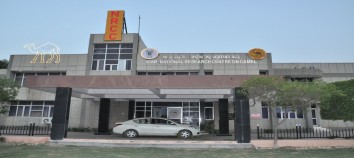Bikaneri Camel
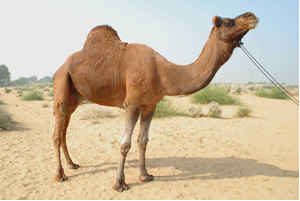
Bikaneri Male
Bikaneri breed of camel is one of the major camel breeds found in India. The breed derives its name from the city Bikaner which was established by Rao Bika in the 15th century and is known for better draught potential.
- Habitat and Distribution
Bikaneri camels are predominantly bred in Bikaner and near by districts, such as Sriganganagar, Hanumangarh, Churu, Jhunjhunu, Sikar and Nagaur of Rajasthan and adjoining parts of Haryana and Punjab state. The breeding tract extends in east from 71°53’ to 78°15’ longitude and in north from 24°37’ to 30°30’ latitude. The home tract of this breed is arid and sandy with extreme hot and cold climates.
To collaborate with national and international resources.- Features
The camels of Bikaneri breed are heavily built and are attractive with a noble look. It has good height, strong built and active habits. The colour of the coat varies from brown to black, however in some animals reddish tinge is also found. They have symmetrical body and slightly dome shaped head. The fore head has a well-marked depression (stop) above the eyes, which is characteristic of this breed. Nose is long and extends up to two third of the head. Some camels of this breed have a luxuriant growth of hair on their eyebrows, eyelids and ears, they are called ‘jheepra’. The chest pad is well developed and placed between angles of elbow. The shoulders are strong, broad and well set to chest. Neck is thick, fairly erect, with a marked curve giving a graceful carriage to the head. The udder is well developed in females.
Jaisalmeri Camel
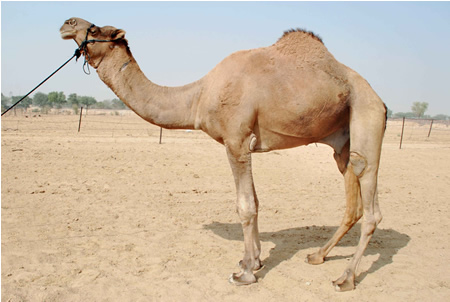
Jaisalmeri
- Habitat and Distribution
The breeding tract of Jaisalmeri breed encompasses the Jaisalmer, Barmer and part of Jodhpur district in Rajasthan. The breeding tract extends in east from 69°30’ to 73°04’ longitude and in north from 24°37’ to 28°15’ latitude with very poor vegetation. Sand dunes are the typical features of the tract.
- Features
The Jaisalmeri camels are of active temperament and are quite tall with long and thin legs. They have small head and mouth with narrow muzzle. The head is well carried on a thin neck and the eyes are prominent. The forehead is not dome shaped and is without any depression above eyes (stop). Also, there is no luxuriant growth of hairs on their eyebrows, eyelids and ears. The body colour is predominantly light brown. The Jaisalmeri camels have thin skin and short hairs on body. The udder is mostly round in shape. It is a medium sized breed of camel.
Kachchhi Camel
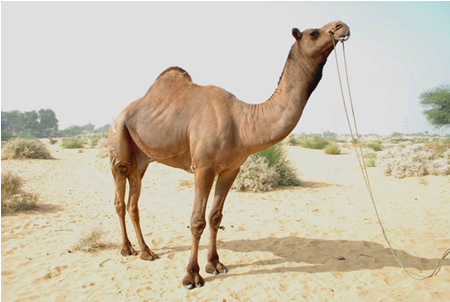 Kachchhi Male
Kachchhi Male
- Habitat and Distribution
The Kachchhi breed inhabits the ran of Kachchh in Gujarat state. The major breeding tract encompasses the Kachchh and Bansakantha districts of Gujarat and it extends in east from 68°20’ to 74° longitude and in north from 22°51’ to 24°37’ latitude. The land is marshy with abundant salt bushes.
- Features
The camels of this breed are generally brown to dark brown in colour with absence of hair on eyelids and ears. The body hairs are coarse. Head is of medium size without distinct “stop”. Body size is medium. Camels of this breed are heavy and dull in appearance. They are stouter and little shorter. They have strong hindquarters, heavy legs, hard and thick foot pads and are well adapted to the humid climate and marshy land of Kachchh. In some animals the lower lip is droopy due to which the teeth are visible from a distance. The udder is well developed and mostly round in shape.
Mewari Camel
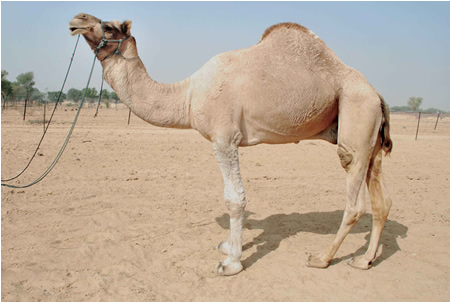
Mewari Male
The Mewari breed of camel has derived its name from the Mewar area of Rajasthan and is well known for milk productin potential.
- Habitat and Distribution
The major breeding tract of the breed encompasses the Udaipur, Chittorgarh, Rajsamand districts and adjoining Neemuch and Mandsour districts of Madhya Pradesh. The camels of this breed can also be seen in Bhilwara, Banswara, Dundarpur districts and Hadoti region of Rajasthan, which can be considered as a minor breeding tract of the breed. The breeding tract extends in east from 73°02’ to 77°20’ longitude and in north from 22°55’ to 25°46’ latitude with fairly good vegetation and rainfall. Average height from main sea level is about 575 meters. The tract consists of hills of the Aravali in Mewar area.
- Features
Genetic improvement of indigenous camels through conventional and molecular
Mewari camels are stouter and a little shorter than Bikaneri. They have strong hindquarters, heavy legs, hard and thick foot pads. Well adapted to travel and carry loads across hills. The body hairs are coarse, which protects them from the bites of wild honeybees and insects. The body colour varies from light brown to dark brown but some animals are almost white in colour, such variation in body colour is generally not seen in other breeds of camel. The head is heavy, set on a thick neck. Unlike the Bikaneri camel, the Mewari camel has no ‘stop’, but its muzzle is loose. Ears are thick and short, set well apart, tail is long and thick. The milk vein is prominent and the udder is well developed in females.
Jalori Camel
 Jalori Male
Jalori Male
-
General description
Local Name/Synonyms : Jalori, Sanchori
Background for such name : Named after the habitat : Jalore Communities responsible for breeding : Dewasi are the traditional camel breeders
Geographical distribution and breeding tract
The Jalori camel derives its name from the place of rearing. The geographical distribution of the breed encompasses chiefly the Jalore and Sirohi districts of Rajasthan. The overall population of Jalori camels in the breeding tract was estimated to be 7906 heads.
Breed Characteristics
Body colour - The predominant colour of Jalori camels is brown. However, it varies from light brown to dark brown.
Head Profile- The head in Jalori camel is medium in size and is well carried on a thin neck. The eyes are prominent. Unlike Bikaneri camel, in Jalori camel, the forehead is not dome shaped and has no “stop” , which is a name given to a depression on the frontal bone at the upper edge meeting the parietal bone. The supraorbital foremen, which is in the form of a deep fissure at the rostro-medial margin of the orbit, is normal in depth as compared to the Bikaneri camel where it is deep. The muzzle is narrow and mostly pointed in camels of Jalore district but rounded in the camels of Sirohi district. Ears are up-right and set well apart. The typical adaptive feature of desert camel, the “Jheepra” is absent in Jalori camel. The lower lip is not droopy as seen in Kachchhi camels.
Body and Stature- It is a medium sized breed of Camel. The Jalori camels are of active temperament. The Neck and legs are thin. The body hairs are coarse in quality and medium in length. The Chest pad is well developed.
Udder Characteristics- The milk vein is small to medium in size. The udder is mostly round in shape. Each udder quarter has a small cone shaped teat with two canals in it. The Jalori Breed is a multipurpose breed of camel and the animals of this breed are being utilized for milk production, tourism, riding and safari.

